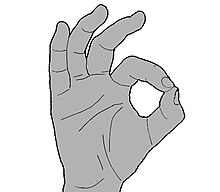A gesture is a form of nonverbal communication.
Understand
[edit]There are practically countless gestures, including hand signals in sign language, that we use during speech or in place of speaking. In day to day life, we may use dozens of different gestures throughout the day without really thinking about them, but when travelling, it is important to be aware of our body language and think about the meaning we are trying to convey.
Some languages and cultures are more non-verbally expressive than others; in Europe, it is a common stereotype that the further south you go, the more physically expressive people are when talking to you. Therefore, a northern European traveller visiting the south may miss certain cues which would be obvious to any local, because they're relying much more on what a person says rather than how they act. In order to understand people from other backgrounds, it helps to understand their gestures.
Certain gestures only have meaning within a specific culture, whereas others exist internationally but have been assigned different meanings in different parts of the world. This is especially important to remember for travellers, as we rely much more on non-verbal communication when we can't speak the language of those around us. So it's more than worth your time to read this article, if only to save yourself from any potentially awkward moments: a gesture which you consider insignificant or positive may be quite offensive elsewhere!
Gesture types
[edit]



- A-ok or Okay — made by connecting the thumb and forefinger in a circle and holding the other fingers straight or relaxed in the air, may signal the word "okay". While the gesture is positive in some countries, in certain parts of central and southern Europe (although not in Spain or Portugal), Turkey, Latin America and the Arab world, the gesture is considered offensive and disgusting. One American political legend states that the then-Vice President Richard Nixon greeted a crowd of Brazilian well-wishers with this symbol when emerging from a plane for a visit of the country. In the U.S.A., this gesture was adopted by white supremacists in the 2010s and is now controversial.
- Fig sign – Made by forming a fist and putting the thumb in between the index and middle fingers, the fig sign is used for the "got your nose" children's game in some countries. In areas including Turkey and some Slavic countries, this is offensive. It is also offensive in Spanish-speaking Latin America, but conversely in Portuguese-speaking Brazil, it is used as a good luck charm.
- Gallic shrug – A typically French gesture, combining shrugged shoulders, raised arms, puffed-out cheeks and a slight sucking or popping noise made with the lips. If you spend any time among the French, you'll find yourself doing it too! The shrug has many meanings, from a simple "I'm not sure" and "I don't care", through to "It's not my fault. Why are you bothering me?" and "I don't agree with what you're saying but can't be bothered to argue." The shrug's more narrow meaning in the Anglosphere may cause you to view it simply as a sign of apathy or rudeness to you, when this could perhaps not be further from the truth; context is key to working out the meaning. Fun fact: the concept for this does not exist in France or the French language! That's despite the testimony of every English speaker who has ever met a French person asserting that it does in fact exist. Maybe it's so common in France, they don't need a word for it...
- Hand-kissing — While this gesture indicates courtesy, politeness, respect or admiration in certain cultures, it is frowned upon in the Muslim world, where this gesture is considered disgusting. The exception is Turkey, where this is, on the contrary, the expected, or at least very well-received, form of greeting, especially by ladies of old age from people decades their junior.
- Middle finger — "The finger" is a fairly universal symbol for a phallus, and is used in many countries as an offensive gesture in lieu of, or alongside, verbal swearing. It has been employed as the gesture equivalent of an F-bomb since Ancient Greek times. On the other hand, Israelis sometimes point with their middle finger, rather than their forefinger, leading to embarrassment in any country where the middle finger has a less innocuous meaning.
- Mountza — This traditional Greek insult is also offensive in several other countries. In Sindh, showing the palm of the hand to someone is called bunda and is considered a very offensive insult, especially if the hand is in close proximity to their face. But let's face it, no-one likes having someone else's hand shoved into their face, so doing this on any of your travels is a big "no".
- Me ne frego — Italian for "I don't care", which is precisely what this gesture means. It is made by rubbing the underside of your chin with your fingers, palm down and your head slightly tilted back. The same gesture is also used in Argentina, which has a significant Italian diaspora; however there it means "No sé", or "I don't know." Argentine visitors to Italy (and vice versa) beware!
- Namaste, or Namaskar is simultaneously a verbal greeting and a physical gesture. As the word is pronounced, the speaker presses their hands together, palms touching and fingers pointing upwards, with thumbs pointing towards and close to the chest. The speaker will also offer a slight bow to the person they're greeting. Of Hindu origin, the greeting is used throughout the Indian Subcontinent, and among various South Asian diasporas around the world. The Thai wai is a similar gesture, used in greeting and while saying goodbye, and also to thank someone or apologize to them.
- Nodding and shaking heads — In North America and most of Europe, a vertical nod of the head means "yes", while a horizontal shake means "no". But in Albania, Egypt, Greece, Iran and Turkey, a single nod of the head actually means "no". Be especially careful in Bulgaria, where the situation is completely reversed from the western norm; people nod to say "no" and shake to say "yes".
- Pointing — Pointing with an extended index finger may be used to indicate an item or person but pointing at another person is considered rude in many cultures. If you have to point, use your whole hand rather than just one finger.
- Roman salute — The right arm is held out forward and straight, with the fingers together and palm facing down. Originally used in Ancient Rome as an Ave Caesar (Hail Caesar), this had a politically neutral and even positive connotation for centuries; you will even see revolutionary portraits of the French National Assembly performing the salute en masse as late as the 19th century. It is still the official oath gesture in Taiwan, so you could see plenty of officials taking their oath of office with an extended arm in front of Sun Yat-sen's portrait.
- In contemporary Europe and North America, the much more commonly-known variant is the fascist or Nazi salute, whereby the arm is slightly erect; this is obviously considered offensive in almost every European country. In Germany and several countries that were under Nazi occupation in World War II, performing this salute is a criminal offence, even if intended as a "joke" or as a faithful reenactment of the original Roman hail.
- Shaka — Make a fist, and extend your thumb and little finger. In Hawaii, this is often used to convey the "aloha spirit" of love, or as a gesture of thanks.
- Sign of the horns — The index and little fingers are held erect, while the middle and ring fingers are held down by the thumb. This has numerous contradictory meanings around the planet. In Hinduism and conservative Catholic countries, it has traditionally been used to ward off evil spirits and demons, and it is associated with the Devil in many Christian societies. In Mediterranean and Latin countries, it is also used as an offensive gesture to imply cuckoldry. On the other hand, in Anglo-Saxon culture, the horns are much more positive, having been associated with rock and heavy metal music since the time of The Beatles. In the United States, they are also used in sports fandom and have a notable relationship with the University of Texas, whose mascot is a Texas longhorn.
- Thumbs up — In many Western countries, the thumbs up is symbol of affirmation or positivity; however in some Islamic countries it is the equivalent of showing the middle finger. When diving, the thumbs up indicates that you want to return to the surface (the okay symbol is used as an affirmation).
- V sign — In large parts of the world, holding the forefinger and middle finger erect, either with the palm facing inward or outward, is a sign for peace or, in the Second World War, "V for victory". It is also a popular pose for photos, especially in East Asia. However, if you make this sign in Britain, Ireland, Australia or the Indian Subcontinent, be sure to have your palm facing outwards, as the reverse is a rude gesture equivalent to showing someone the middle finger.
- Waving — In many parts of the world, waving is a friendly gesture, indicating "hello." However, in Malaysia, at least among the Malays in rural areas, it means "come over," similar to the index finger bent toward the body, a gesture which is used in certain Western countries, and should be used only for that purpose. Similarly, a British traveller in Spain may mistake a wave goodbye involving the palm facing the waver (rather than the person being waved at) as a gesture to come back.

